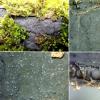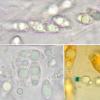
11-03-2025 10:16
 Michel Hairaud
Michel Hairaud
Bonjour , Récolte sur tronc mort de Carpinus. Fo

10-03-2025 18:51
Juuso ÄikäsThese apparent Cryptodiscus fruitbodies with a pal

15-02-2025 22:05
 Robin Isaksson
Robin Isaksson
Hi!Anyone knows this?Conidia around 6-11 x 6-8 um,

08-03-2025 16:21
Yanick BOULANGERBonjourDialonectria episphaeria sur Diatrype stigm

09-03-2025 08:32
Me mandan el material seco de Galicia (España) re

08-03-2025 08:47
 Danny Newman
Danny Newman
Hello AscoFrance, I believe I may have found the

06-03-2025 21:53
 Charles Grapinet
Charles Grapinet
Hello, I found a very abundant Phaeosphaeria on t

06-03-2025 17:23
Found 13/2/25 on moss, very far away, only almond
Pyréno résupiné sur Carpinus
Michel Hairaud,
11-03-2025 10:16
 Bonjour ,
Bonjour , Récolte sur tronc mort de Carpinus. Forêt de Chizé
J'ai cru à un Annulohypoxylon , mais micro différente.
Spores hyalines, à deux cellules de tailles très différentes, largement fusoïdes.
Asques amyloïdes
Je n'ai pas trouvé de nom dans la base d'Ascofrance en cherchant par le support Ces photos sont elles suffisantes pour m'apporter de l'aide ?
Si oui merci
Amitiés. Michel
Enrique Rubio,
11-03-2025 11:26
Re : Pyréno résupiné sur Carpinus
Bonjour Michel.
Il me parait Biscogniauxia anceps immature.
http://www.ascofrance.com/search_recolte/2003#
Il me parait Biscogniauxia anceps immature.
http://www.ascofrance.com/search_recolte/2003#
Alain GARDIENNET,
11-03-2025 12:08
Re : Pyréno résupiné sur Carpinus
Salut Michel,
Je confirme les dires d'Enrique bien entendu. Par chez toi il est courant, surtout sur Corylus.
Plutôt que de pyréno résupiné, je parlerais de stroma étalé.
Bonne fin de journée.
Alain
Je confirme les dires d'Enrique bien entendu. Par chez toi il est courant, surtout sur Corylus.
Plutôt que de pyréno résupiné, je parlerais de stroma étalé.
Bonne fin de journée.
Alain
Michel Hairaud,
11-03-2025 12:11

Re : Pyréno résupiné sur Carpinus
Cher Enrique,
Merci pour cette réponse rapide et pertinente.
J'avais ignoré le genre Biscogniauxia, dont je connais 2 ou 3 espèces, pour la couleur habituelle des spores et le fait qu'elles n'ont qu'une cellule !
La fiche de Jacques ( http://pyrenomycetes.free.fr/biscogniauxia/html/Biscogniauxia_anceps.htm) montre que c'est la seule espèce européenne à spores à 2 cellules et que la maturité peut être assez longue, et même qu'elles peuvent germer avant maturation complète !
Amitiés.
Michel
Merci pour cette réponse rapide et pertinente.
J'avais ignoré le genre Biscogniauxia, dont je connais 2 ou 3 espèces, pour la couleur habituelle des spores et le fait qu'elles n'ont qu'une cellule !
La fiche de Jacques ( http://pyrenomycetes.free.fr/biscogniauxia/html/Biscogniauxia_anceps.htm) montre que c'est la seule espèce européenne à spores à 2 cellules et que la maturité peut être assez longue, et même qu'elles peuvent germer avant maturation complète !
Amitiés.
Michel
Michel Hairaud,
11-03-2025 12:14

Re : Pyréno résupiné sur Carpinus
Oui Alain, Stroma étalé . (Il y a des matins où le cerveau , le mien en tout cas, se prend pour du gruyère- non suisse bien sûr) M'

